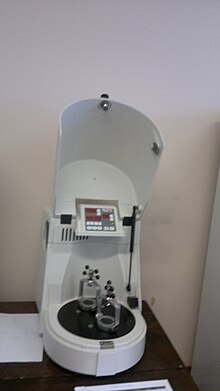Planetary mill
The planetary mill , also known for a long time as a planetary ball mill , is a special form of the ball mill that is used in particular for the finest grinding of very hard materials. It belongs to the mills with indirectly driven or moving grinding media. The grist is essentially crushed by impact, shear and pressure.
Working principle
The planetary mill consists of at least one grinding chamber. Several of these crushing chambers, which perform a rotational movement, are arranged vertically or horizontally. The grinding vessels move around a common main axis, which creates a planetary motion. These movement mechanisms lead to a high stress intensity with an effective comminuting effect due to the centrifugal and gravitational acceleration forces occurring in the main axis and the axis of rotation of the grinding chamber. Forces also become effective when a Coriolis acceleration occurs. There is an intensive superimposition of the grist-grinding media mixture. Due to the energy densities generated during the grinding process, a significantly higher specific throughput and a significant reduction in the size of the grinding chamber compared to normal ball mills (tumble mills) can be achieved.
application
Planetary mills are often used for fine comminution as small-scale mills for special tasks. They have proven themselves there. In the large-scale application of these mills, considerable mechanical engineering problems arise, which are caused by the high energy transmission densities. The design of the drives, the continuous supply of the ground material and the cooling of the grinding chambers when using dry grinding are problematic.
literature
- Karl Höffl: Shredding and classifying machines . VEB German publishing house for basic industry, Leipzig, 1985
- Michael Juhnke: Development of a planetary mill for fine comminution with high purity requirements . Cuvillier, Göttingen 2006, ISBN 978-3-86727-985-7 (also dissertation, TU Clausthal 2006).
